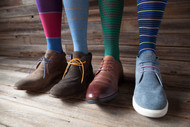A Deep Dive Into Socks - Length, Types, and Fabrics Explained
Oct 03, 2022
A Deep Dive Into Socks - Length, Types, and Fabrics Explained
This article covers everything you need to know about socks, from the correct fabric length, types, purpose, and styling options.
You are at the right place if you have any burning questions about socks. We have created this comprehensive guide to equip you with the knowledge of choosing the perfect socks for any occasion.
From formal black tie events to streetwear fashion, this article will help you deliver the looks of your choice without breaking a sweat. Before we discuss the types of socks and how to choose the right ones for your needs, we must understand the various sock lengths.
Sock Lengths
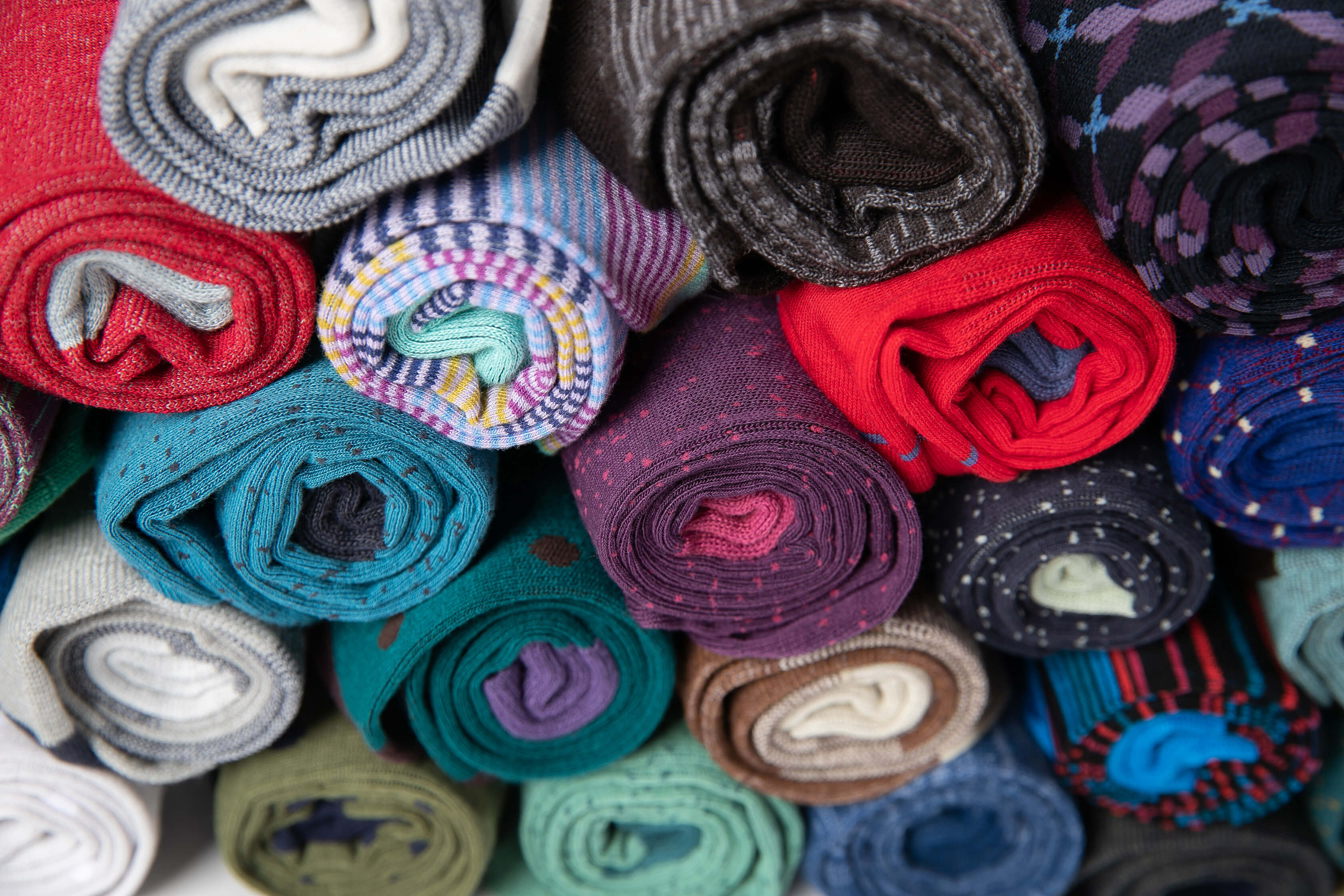
Sock length and sock types are often used interchangeably. But, there is a difference between them. Sock type refers to its material and purpose, such as a cotton crew sock, wool dress sock, casual sock, or ankle-length hiking sock. The length of a sock refers to more than just its height.
While there is more to socks than their height length, it is an important feature, so let’s get that out. Here are socks categorized based on their length, from shortest to longest:
-
Cloth Inserts
Cloth inserts tend to slip and bunch up, whereas no-show socks do the same job with better functionality. However, cloth insoles can be a great option depending on the shape of your feet.
-
No Show Socks
Also known as a loafer or low-profile socks, no-show socks are designed to stay hidden inside your shoes, giving an invisible feel. No-show socks are ideal to be paired with low-top shoes such as sneakers, loafers, and boat shoes.
Perfect for summertime, no-show socks enhance your look when paired with shorts. No-show socks are a great choice when wearing cropped or cuffed trousers and chinos during warmer weather.
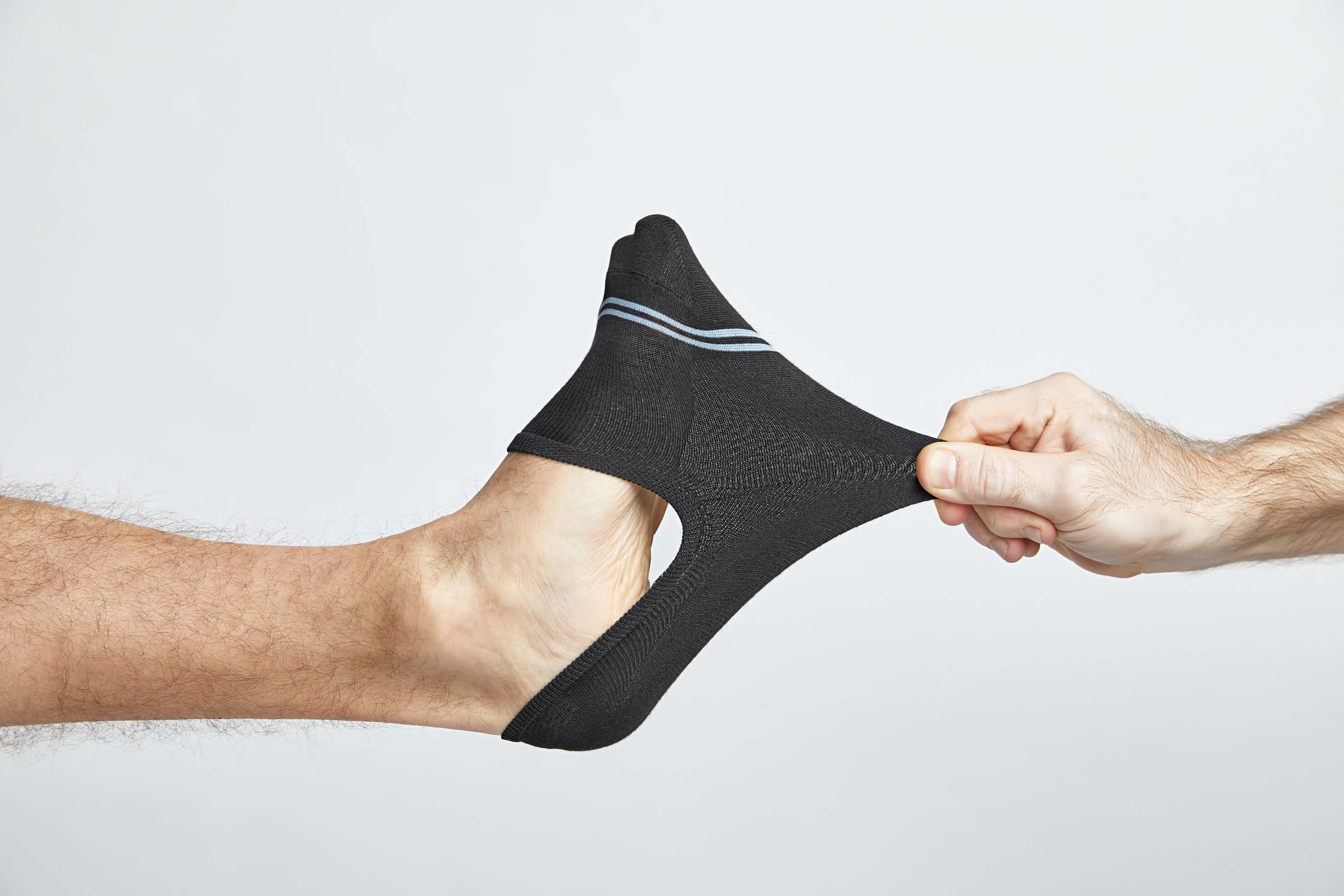
No-show socks allow your ankles to breathe in scorching heat during the stifling summer months. DeadSoxy’s Luna no-show invisible socks are a great addition to your gym attire. However, the sockless look isn’t accepted when paired with formal outfits unless it is for casual summer suiting.
-
Ankle Socks
Ankle socks fall between crew socks and no-show invisible socks lengthwise. They are longer than no-show socks but shorter than crew socks. Ankle socks end right at your ankles and aren’t meant to be hidden.
Ankle socks are ideal for running, hiking, or playing sports. They have the perfect length to be paired with running shoes or any workout sneaker. Ankle socks are in two lengths - quarter socks and low-cut ankle socks.
-
Quarter Socks
Quarter-length socks are about 6” tall and end right above the ankle and below mid-calf. Quarter ankle socks pair well with mid or high-top shoes and prevent chafing around your ankles. Quarter-length socks can be used as an alternative to crew-length or over-the-calf socks when the weather is unbearably hot.
However, if you want a no-break look, quarter-length socks may fall short in providing coverage while sitting or when your pants ride up your legs.
-
Low-Cut Socks
Low-Cut ankle socks are barely visible above a pair of sneakers and sometimes have a tab on the back to protect your heel from rubbing against your shoes. Low-cut socks add a touch of minimalism and laid-back comfort, which is why they are a popular choice for athletes who wear them as running socks, cycling socks, or even workout socks.
Styling Tip!
Replace ankle socks with no-show socks when wearing low-top sneakers for a well-groomed look.
-
Crew Length Socks
Crew length socks are the most popular for men and can usually be found in most department store’s underwear sections. Crew socks go past your ankles and sit around the mid-to-upper calf.
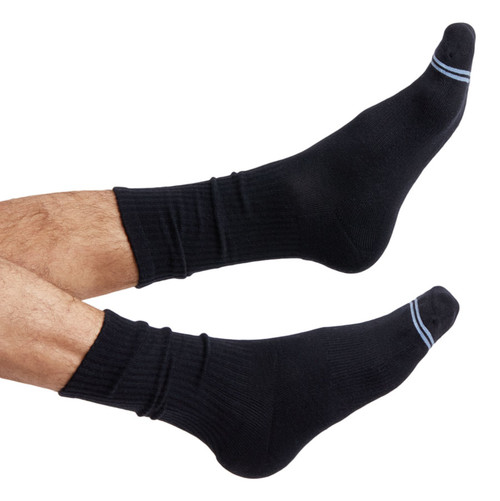
Longer than no-show and ankle socks, Crew length socks don’t go up to your knees like over-the-calf socks. Crew socks look best when worn with sneakers and jeans. Crew-length socks are usually made from 100% cotton; however, cotton-polyester blends and other synthetic materials such as wool and silk are gaining popularity.
While fabrics such as extra fine wool and silk are preferred for dressier socks, thick wool crew socks offer great comfort and warmth when worn with boots during fall and winter.
Choosing the correct size of socks is vital, especially if you find it annoying when socks drop down to your calf. It happens when the choice of socks is too big. If you buy smaller socks, they may restrict circulation, so when in doubt, look for socks that fit your feet rather than settling for one-size-fits-all.
DeadSoxy’s Casual Athletic Lounger - Gray would be your new favorite everyday casual crew sock that offers a clean, uncomplicated, and basic design with just enough relaxed vibe.
-
Over The Calf Socks
Over-the-calf socks or OTC socks are considered fancier than crew-length socks since they are made from high-end fabrics such as wool or silk. Compared to crew-length socks, OTC socks don’t fall down your calf over time and stay in place. Since OTC socks sit right below your knee, the tapered shape of your calf prevents the socks from sagging or dropping down.
When planning on buying over-the-calf socks, keep in mind the shoes and outfits you will be pairing them with. If you plan on pairing the calf socks with suits in the summertime, consider the socks' material; breathable OTC socks made from fine materials such as lightweight wool, cotton, or silk would be ideal.
Styling Tip!
Consider OTC socks made with thicker wool for extra warmth when wearing boots in winter.
-
Over-the-Knee Socks
When in need of extra-tall socks, Over-the-Knee socks or thigh-high socks are the best matches when in need of extra-tall socks. If OTK socks are held in place using garters, sometimes they are referred to as stockings. They are super-long socks that pair well with boots either pulled up or scrunched slightly around the knee.
Over-the-knee socks look great when worn with a skirt or dress. You can wear OTK socks over a pair of tights or leggings to utilize the warmth it provides while serving fall or winter looks.
-
Knee Socks
Knee socks are perfect for boots. These socks sit right below your kneecaps and come in various fun prints. Knee socks pair best with skirts, dresses, and shorts, enabling you to wear style statement pieces with funky sock designs while keeping your legs warm.
-
Dress Socks
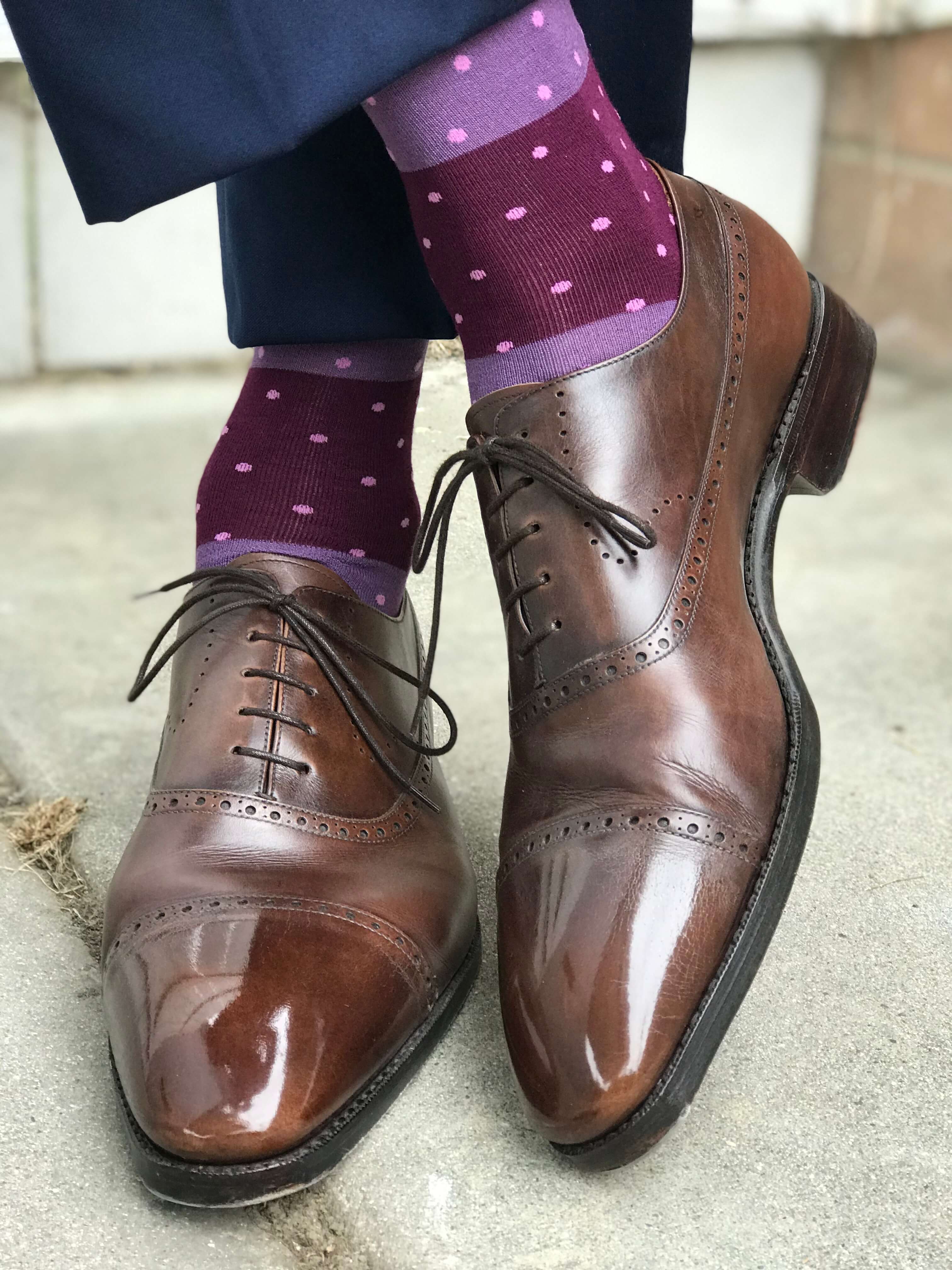
Dress socks are specially paired with dress shoes and formal attire. Perfect for formal events, dress socks can be styled for a more laid-back setting, taking your casual outfit to the next level.
For a subtly sophisticated look, neutral dress socks work best, or you can add flair to a basic business casual look. DeadSoxy’s Burch is the perfect boardroom dress sock for a simple business event paired with a formal suit.
The ideal length of dress socks has varied over the years dating back to when exposed ankles were considered fashion blasphemy. A good dress sock sits at the mid-calf length. A good rule is to steer clear of dress socks below your calf. The shorter the size of your socks, the riskier it is to flash bare skin during formal events.
-
Athletic Socks
Foot problems are part and parcel of an athlete’s life. It can occur in the form of joint irritation, athlete’s foot, or caused by wearing the wrong types of socks. Choosing the correct type of socks is vital in supporting athletes to deliver their peak performance.
Athletic socks offer cushioning for the feet that prevent irritation and are designed to repel the body's extra force when jumping, running, or bouncing around. Athletic socks are equipped with unique moisture-wicking capabilities that eliminate the chances of moisture getting trapped and transferred inside socks, leaving your feet dry.
Athletic socks can are available in various lengths based on your exercise level and requirements. If you are buying athletic socks for running activities, a good pair of high moisture-wicking athletic socks will prevent athlete’s foot. You wouldn’t need extra padding when cycling, which is why a thin pair of socks protect against chafing. For shorter hikes, consider athletic socks with better moisture-wicking capabilities; athletic socks with padding will keep your feet warm for longer walks. To add support to your legs when weight lifting, it is suggested to choose higher socks such as mid-calf or knee highs.
DeadSoxy’s casual athletic loungers, like the navy tie-dye, have exceptional moisture-wicking capabilities with an extra cushion on the footbed for maximized comfort. Deadsoxy’s athletic loungers are crew length and equipped with Stay-Up Technology that keeps your socks in place.
-
Compression Socks
Compression socks fall in a different category than those we have discussed so far. These are designed to enhance circulation by creating a pressure gradient by applying targeted pressure to help push blood and fluid out of your legs. Compression socks fit snugly around your ankle with the maximum compression that gradually decreases in tension as we move to the top.
Compression socks are ideal for people that spend long periods sitting or standing, which can lead to blood pooling in the legs. These socks also aid post-exercise recovery and treat mild to severe venous issues. Compression socks are usually available in knee-high and thigh-high lengths.
To Cushion Or Not To Cushion?
Medical issues, weather conditions, or injury, irrespective of why you require extra support between your foot and your shoe, going for padded socks are always a great choice. Cushioned socks are perfect for when your shoes are a little loose, and you want extra padding to enhance the fitting of your shoe.
When buying socks with cushion, look for socks that offer cushioning around the heel and ball of your foot. In general, thicker socks are recommended to be worn during the fall and winter for extra warmth and added comfort.
Sock Fabrics Demystified
100% cotton socks have been around since the origin of socks. However, numerous fabric blends in the market enhance socks' performance, including natural-synthetic combinations or even 100% synthetic.
Choosing your sock fabric wisely depends on your specific needs, such as the occasion, purpose, and outfit. Let us take a look at the different types of materials used in sock manufacturing:
-
Cotton
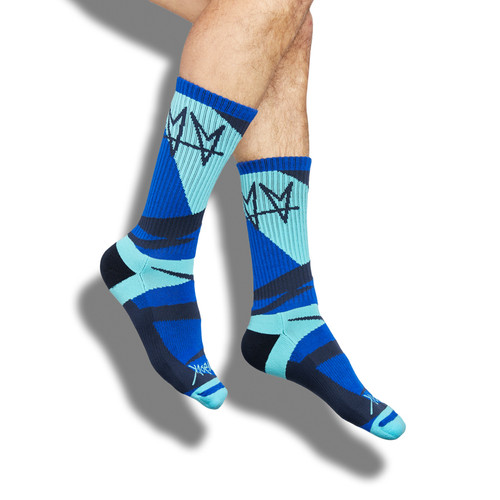
Cotton is the most widely used fabric when it comes to sock manufacturing. Cotton is sturdy and soft; it retains heat and stretches easily. It is often blended with other synthetic fibers for enhanced performance and durability.
100% cotton socks go well with casual and dressy outfits. However, these socks aren’t ideal for performance wear during workouts, exercising, hiking, etc.
-
Wool
Wool is the second most popular for socks due to its excellent wrinkle resistance, durability, and ability to absorb moisture and odor. Wool keeps you cool during warm seasons and warm during harsh winters, all the while maintaining its form after many washes. It is stretchy but durable, meaning the sock holds its shape, making it nature’s performance fabric.
Wool socks are an excellent choice when hiking, especially when packing light, as they enable you to wear the same socks multiple times without washing. You can wear wool socks and air them out by letting them dry before wearing them again.
-
Bamboo Rayon

Bamboo rayon is the latest sensation in the world of socks. It is breathable and silky while offering hypoallergenic and antimicrobial properties. Bamboo is more durable than cotton and is one of the fastest-growing plants on earth. Its fibers are gaining popularity for apparel, including socks.
DeadSoxy’s Euler is made from the softest yarn known to man, Bamboo. Bamboo socks are not made from 100% bamboo; instead, they are made from rayon, a manufactured fiber made from regenerated cellulose. While rayon can be made from other sources of cellulose, Bamboo offers unparalleled softness, durability, and hypoallergenic and antimicrobial properties.
-
Modal
Modal is a type of rayon that is usually derived from beech trees. Modal is as soft if not softer than cotton but outperforms cotton in various ways. It is vital, stable, and durable, with outstanding resistance to shrinking in the washer or dryer with built-in moisture-wicking properties.
Modal, especially micro-modal, is a great, luxurious material used in manufacturing underwear, undershirts, and socks.
-
Silk
Silk is another solid natural fiber that offers unparalleled comfort to your skin. However, we advise you not to pick silk socks in the heat or if your feet tend to be on the sweatier side. While Silk is light, elastic, and sweat sensitive, a lesser known fact is that one should never wear 100% silk socks.
-
Alpaca
Alpaca wool is lightweight and water resistant. Alpaca wool is better than sheep wool, making it highly insulating. Like cashmere, alpaca wool is soft and wrinkle-resistant. Alpaca wool is warmer than merino wool and is ideal for cold weather. Alpaca wool is expensive as it is a premium fabric, but perfect for winter with boots and lasts for years to come.
-
Cashmere
Cashmere is luxuriously soft, lightweight, and naturally insulating. It is perfect for crew length and over-the-calf dress socks during the winter and is made from soft cashmere goat hair.
-
Polyester
Polyester is a petroleum-based synthetic fiber blended with natural fibers such as cotton to utilize its specific properties in smaller concentrations. Polyester is equipped with properties including quick drying and retaining dye.
A small amount of polyester can help keep your colorful socks vibrant for a long time. Additionally, it helps your socks dry quickly compared to 100% cotton socks. However, 100% polyester socks wouldn’t offer breathability or comfort as most other materials in the market have to offer.
Top Five Sock Styling Tips
When it comes to fashion, even the smallest details matter. Socks, for example, may seem like an insignificant part of an outfit, but they can make a big impact on the overall look. To help you navigate the world of sock styling, we've put together a list of golden rules to follow. From matching your socks to your pants to experimenting with patterns and colors, these tips will help you step up your sock game and make a statement with your footwear. So, whether you're looking to dress up for a formal event or add some personality to your everyday look, these styling tips will have you covered. Let's dive in and learn how to make the most out of this often-overlooked accessory.
- Match your socks to your pants, not your shoes. This creates a cohesive look and prevents your socks from clashing with the rest of your outfit.
- Show some ankle. For a modern, stylish look, opt for socks that sit just above your shoes, leaving a small sliver of skin exposed.
- Experiment with patterns and colors. Socks are a great way to add a pop of personality to an otherwise neutral outfit. Don't be afraid to try bold prints or bright hues.
- Invest in quality socks. Cheap socks are often made with low-quality materials that wear out quickly and lose their shape. Look for socks made with high-quality materials like merino wool or bamboo.
- Pay attention to the occasion. Different occasions call for different socks. For formal events, stick to classic black or navy socks. For more casual settings, have fun with colors and patterns.
It's incredibly important to take great care of your socks, as they can easily become worn and damaged over time. To help extend the life of your socks, DeadSoxy offers a mesh sock wash bag that helps protect your socks from damage during the washing process.
Click here to check out DeadSoxy's mesh sock wash bag.
-
Conclusion
There is going to be the right combination of length, material, and cushioning that works specifically for you when buying socks. For instance, cotton no-show socks with boat shoes would be ideal for a backyard barbecue. However, fine cotton over the calf socks with no cushioning would be an excellent choice for a job interview requiring a suit and tie.
We hope this comprehensive guide of everything you need to know about socks can help you prepare for any situation. Keep in mind the factors that make great socks - fabric, cushioning, moisture-wicking properties, insulation, and, finally, the sock length and size.
DeadSoxy’s patented TrueStay™ technology ensures your dress socks stay in place, exactly where you need them. Get in touch with us today to explore the world of premium dress socks.
Follow DeadSoxy on Instagram to check out their products and stay updated on their developments and new releases.
CONTACT:
Company: DeadSoxy
Email:
j.simmons@deadsoxy.com
Phone: 972-861-0103
Website:
www.deadsoxy.com



